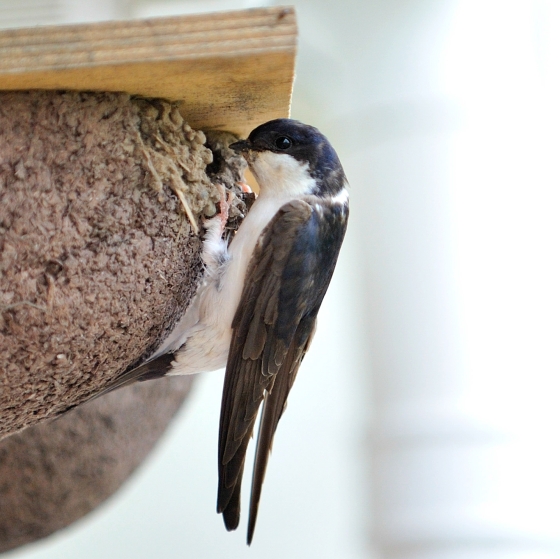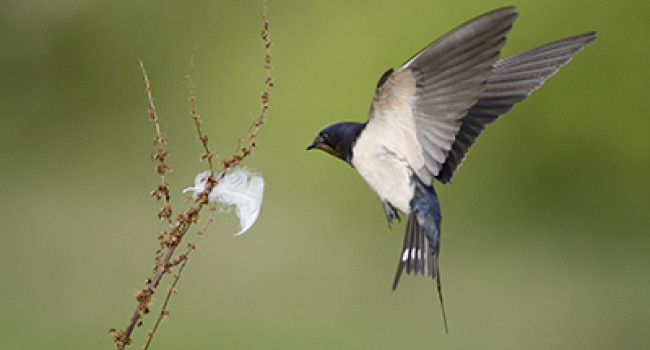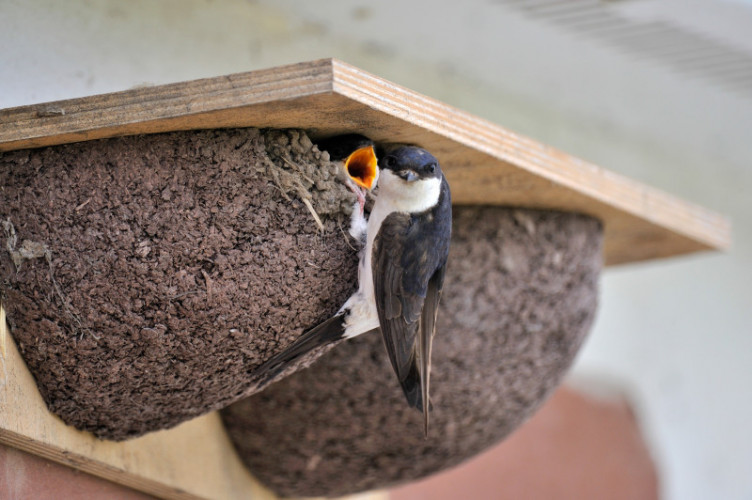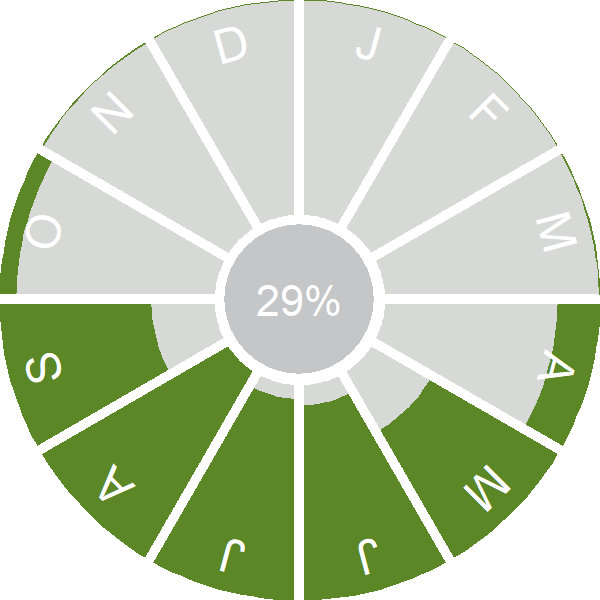House Martin
Delichon urbicum (Linnaeus, 1758)
HM
 HOUMA
HOUMA  10010
10010

Family: Passeriformes > Hirundinidae

This small hirundine is a familiar bird due to its habit of nesting in small colonies under the eaves of our homes.
Migrating to the UK & Ireland in early spring, House Martins construct nest cups from mud, and lay two broods on average in a single summer. Birds, which have a distinctive white rump, can be seen anywhere throughout Britain & Ireland in the summer months. Flocks may be seen overhead in early autumn as they gregariously catch insects to fuel their return migration. Although House Martins migrate to Africa, the exact non-breeding range of House Martins that breed in the UK & Ireland is still not known.
Declines in House Martin numbers led to this species being added to the UK Red List in 2020. These declines have been most severe in the south and east of Britain. The reasons underpinning this decline are not well understood, although birds that build nests on PVC as opposed to brick, concrete or wood have much lower breeding success, with nests more likely to collapse on the PVC substrate.
Exploring the trends for House Martin
Our Trends Explorer will also give you the latest insight into how the UK's House Martin population is changing.
trends explorerIdentification
House Martin identification is often straightforward. The following article may help when identifying House Martin.
Identifying Hirundines and Swift

With their swept back wings and aerial lifestyle hirundines (Swallow, Sand and House Martins) and the similar, but unrelated, Swift often cause ID headaches. Let us help you to separate these amazing summer visitors.
SONGS AND CALLS
Listen to example recordings of the main vocalisations of House Martin, provided by xeno-canto contributors.
Flight call
Call
Song
Develop your bird ID skills with our training courses
Our interactive online courses are a great way to develop your bird identification skills, whether you're new to the hobby or a competent birder looking to hone your abilities.
Browse training coursesStatus and Trends
Population size and trends and patterns of distribution based on BTO surveys and atlases with data collected by BTO volunteers.
CONSERVATION STATUS
This species can be found on the following statutory and conservation listings and schedules.
POPULATION CHANGE
The House Martin's loosely colonial nesting habits and its strong association with human settlements mean that it is extraordinarily difficult to monitor. Anecdotal evidence of decline is often unreliable, because demise of a colony may be balanced by single nests or small groups becoming established elsewhere. For these reasons, study areas should be large, covered thoroughly, and ideally randomly selected. A first national survey designed on these principles was undertaken by BTO in 2015 (see here ).
The available long-term data suggest a rapid decline, although the confidence intervals are wide and the BBS's first decade or so showed an increase. However the BBS map of change in relative density between 1994-96 and 2007-09 indicates that there were strong decreases over that period across southern and midland England and in Northern Ireland and increases in northern Britain and parts of the southwest. More recent BBS data confirm that the declines over the period 1995-2018 have mainly occurred in England and that numbers have increased in Scotland and Northern Ireland over the same period. The species was moved from the green to the amber list in 2002, because of moderate decline in the CBC trend for 1974-99, and is listed as of European concern following declines elsewhere in Europe (BirdLife International 2004). A decline has occurred across Europe since 1980 (PECBMS: PECBMS 2020a>).
| UK breeding population |
-44% decrease (1995–2022) 
|
Exploring the trends for House Martin
Our Trends Explorer will also give you the latest insight into how the UK's House Martin population is changing.
trends explorerDISTRIBUTION
Breeding House Martins are widespread in Britain and Ireland with the exception of the highest parts of the Scottish Highlands, Shetland, the Outer Hebrides and some exposed parts of the west coasts of Scotland and Ireland. Densities are highest in the eastern half of Ireland. Abundance is especially low in some urban areas, including London, Birmingham, Dublin and Belfast, despite the species’ reliance on buildings for nesting.
Occupied 10-km squares in UK
| No. occupied in breeding season | 2670 |
| % occupied in breeding season | 88 |
| No. occupied in winter | 98 |
| % occupied in winter | 3.2 |
European Distribution Map
European Breeding Bird Atlas 2
Breeding Season Habitats
| Most frequent in |
Villages 
|
Relative frequency by habitat
Relative occurrence in different habitat types during the breeding season.

DISTRIBUTION CHANGE
Change in occupied 10-km squares in the UK
| % change in range in breeding season (1968–72 to 2008–11) | +2.9% |
| % change in range in winter (1981–84 to 2007–11) | --56% |
SEASONALITY
House Martin is a summer visitor, arriving through April and May and present until September/October.

Movement
Information about movement and migration based on online bird portals (e.g. BirdTrack), Ringing schemes and tracking studies.
An overview of year-round movements for the whole of Europe can be seen on the EuroBirdPortal viewer.
RINGING RECOVERIES
View a summary of recoveries in the Online Ringing Report.
Foreign locations of birds ringed or recovered in Britain & Ireland

Biology
Lifecycle and body size information about House Martin, including statistics on nesting, eggs and lifespan based on BTO ringing and nest recording data.
PRODUCTIVITY & NESTING
Number of Broods 
|
2 |
Egg Size 
|
19×13 mm Weight = 1.8 g (of which 6% is shell) |
Exploring the trends for House Martin
Our Trends Explorer will also give you the latest insight into how the UK's House Martin population is changing.
trends explorerSURVIVAL & LONGEVITY
View number ringed each year in the Online Ringing Report
Exploring the trends for House Martin
Our Trends Explorer will also give you the latest insight into how the UK's House Martin population is changing.
trends explorerBIOMETRICS
Wing Length 
|
Adults | 110.5±3 | Range 106–115mm, N=6214 |
| Juveniles | 109.5±2.9 | Range 105-114mm, N=2280 | |
| Males | 110.6±3.6 | Range 106–115mm, N=1841 | |
| Females | 110.3±2.7 | Range 106–115mm, N=1716 |
Body Weight 
|
Adults | 17.8±1.5 | Range 15.5–20.4g, N=4215 |
| Juveniles | 17.2±1.5 | Range 14.7–19.8g, N=1662 | |
| Males | 17.8±1.4 | Range 15.6–20.2g, N=1323 | |
| Females | 17.9±1.6 | Range 15.4–20.8g, N=1309 |
Feather measurements and photos on featherbase 
CODES & CLASSIFICATION
Ring size 
|
A |
Field Codes 
|
2-letter: HM | 5-letter code: HOUMA | Euring: 10010 |
For information in another language (where available) click on a linked name
Research
Interpretation and scientific publications about House Martin from BTO scientists.
CAUSES AND SOLUTIONS
Causes of change
The causes of the decline are currently unclear. A number of causes have been suggested but remain speculative and robust evidence to identify the main driver(s) of population change is lacking.
Further information on causes of change
Analysis of phenological data has found that the arrival date in the UK has advanced, between the 1960s and 2000s, by 16 days (Newson et al. 2016), although it is not currently known if and how this may affect breeding productivity for this species. Winter weather and food resources may be more limiting than conditions during the breeding season: annual survival rates from RAS sites in the UK for 1994-2004 were positively correlated with maximum monthly rainfall in West Africa. Some declines in survival rate are apparent over this period but they do not correspond well to the period of population decline (Robinson et al. 2008).
A number of breeding season factors have also been suggested as potential causes for the decline and for the contrasting trends between the north-west and south-east of the UK, but these are all speculative and robust evidence to identify one or more of these possible causes as a driver of population change is lacking. Previous research found that clutch sizes and the number of second broods varied by latitude and longitude (Moller 1984,Bryant 1975 ), and that breeding success is predominantly affected by foraging conditions (Bryant 1975, 1979,Poulin et al. 2010). Hence it is feasible that factors such as climate change and land use changes could have caused increases in breeding productivity in some parts of the UK and decreases elsewhere, causing the observed geographical variation in trends. However in the absence of demographic data it is not possible to confirm this. Competition with House Sparrow for nest sites has also been found to affect populations at local colonies (Tryjanowski & Kuczynski 1999). However, there is no evidence as yet to show that the overall proportion of usurped nests has changed over time and hence that House Sparrows could be having a population level effect.
Information about conservation actions
The main drivers of the decline for House Martin are not yet clear; hence, it is uncertain which conservation actions are most likely to directly benefit the species. However, it is known that House Martins usually prefer to use existing nests remaining from the previous year and will be more likely to raise two broods if they existing nests (e.g. Piersma 2013). Therefore, wherever possible, homeowners should leave existing nests in place over winter to enable them to be reoccupied the following spring.
Whilst research has not yet confirmed what factors are likely to be driving the decline and has therefore not tested possible solutions, there are some other actions which individuals and organisations can take as a precaution to address some of the potential factors whilst research is ongoing. Artificial nests will sometimes be used by House Martins and can therefore be provided alongside or to replace natural nests, particularly in cases where soffits and/or wall surfaces are replaced with PVC materials as anecdotal observation suggests such nests are more likely to collapse than those built on wood or brick surfaces. Another action which could be considered by site managers is the creation of 'House Martin towers' to provide potential nesting sites for House Martins on protected areas away from buildings. Such towers have been built for both House Martins and Swifts in several European countries.
Warmer, drier conditions as a result of climate change has also been suggested as a possible cause of the decline, and some homeowners have created muddy puddles during times of drought but the efficacy of this has not been tested.
Previous research suggests that breeding success may be predominantly affected by foraging conditions (Bryant 1975 , Bryant 1979; Poulin et al. 2010). Therefore, wider scale policies which aim to ensure habitat in the wider countryside supports invertebrates may also be important, e.g. reducing herbicide and pesticide use and creating natural habitat features.
PUBLICATIONS (2)
Identification of putative wintering areas and ecological determinants of population dynamics of Common House-Martin <i>Delichon urbicum</i> and Common Swift <i>Apus apus</i> breeding in Northern Italy
To identify the causes of population decline in migratory birds, researchers must determine the relative influence of environmental changes on population dynamics while the birds are on breeding groun

Using citizen science to assess drivers of Common House Martin breeding performance
Survey determines drivers of House Martin breeding success
Latest research based on the House Martin Survey shows that one of the simplest ways to help House Martins is to provide artificial nesting cups.
Links to more studies from ConservationEvidence.com
- Effects of nest-box density on the behavior of tree swallows during nest building
- Creation of artificial sand martin Riparia riparia burrows at Kingfishers Bridge, Cambridgeshire, England
- Composition of cavity-nesting bird communities in montane aspen woodland fragments: the roles of landscape context and forest structure
Read more studies about House Martin on Conservation Evidence >
Would you like to search for another species?













Share this page